|
Chorale Melodies used in Bach's Vocal Works
Meinen Jesum laß ich nicht |
|
Melody & Text | Use of the CM by Bach | Alternate Melodies | Use of the CM by other composers |
| |
|
Melody & Text: Zahn: | EKG: |
|
Melody: Zahn: 3449 | EKG: (see below) |
|
Andreas Hammerschmidt (1611 or 1612 - 1676) was the composer of this melody which first appeared in “Fest-, Buß- und Danklieder” for 5 voices and 5 instruments (ad lib) and bc. This collection is dedicated to the Electress Magdalena Sibylla of Saxony and the printing was dated October 29, 1658 and published in Zittau.
Alfred Dürr and the NBA editors do not specifically refer to the composer of this important melody; however, Charles Sanford Terry (and W. Gillies Whittaker who refers to the former’s research) and Friedrich Smend have given this specific reference. The original shape or form of the melody from this edition is not available for verification, but there is ample evidence that Hammerschmidt and the chorale text’s author Christian Keymann knew each other well and worked together in presenting chorales such as the above to a wider audience. In a collection of chorales “Mnemosyne sacra” (Leipzig, 1646) published by Keymann, five of the chorale melodies are by Hammerschmidt.
Gottfried Vopelius (1645-1715) published in 1682 a very comprehensive chorale book containing more melodies than any other hymnal of the time, most of which were without musical notation. This is a standard source reference for comparing and documenting chorale melodies which Bach used. Here is more information about this from Percy M. Young’s article on Vopelius in the Grove Music Online (Oxford University Press, 2005) acc. 12/15/05 The complete name of the hymnal in German is: |
|
Neu Leipziger Gesangbuch, von den schönsten und besten Liedern verfasset … mit 4. 5. bis 6. Stimmen, deren Melodeyen theils aus Johann Herman Scheins Cantional, und andern guten Autoribus zusammen getragen, theils aber selbsten componiret (Leipzig, 1682).
|
|
This compendium, comprising 1104 pages and important for the study of church music in Leipzig in the later 17th century, contains 55 pieces for solo voice, two in three parts, 241 in four, 14 in five and four in six, as well as two Passions (after Johann Walter (i)) and a Resurrection history (after Antonio Scandello); there are also 113 items of which only the texts are given. Where necessary, Latin and German texts are both printed. Among the composers represented are Joachim á Burck, Johannes Crüger, Johann Christoph Demantius, Melchior Franck, Hammerschmidt, Tobias Michael, Michael Praetorius, Johann Rosenmüller, Schelle, Heinrich Schütz and Johann Hermann Schein, whose Cantional (1627), from which 96 pieces were taken, was the mainstay of the collection. Vopelius included three pieces of his own, among them the chorale aria Also hat Gott die Welt geliebt, which Bach used (BWV 68). An interesting development of a theme of Vopelius by Rosenmüller is given by Moser.
In the following article in the Grove Music Online, Oxford University Press, 2005, acc. 12/15/05, Michael Finkelman refers specifically to Bach’s use of the oboe d’amore as an obbligato instrument surrounding the singing of the chorale “Meinen Jesum laß ich nicht”: |
|
Oboe d’amore
(It.: ‘oboe of love’; Fr.hautbois d’amour; Ger. Liebes[h]oboe). A mezzo-soprano oboe in A with a bulb bell (fig.24a), developed in south-central Germany during the second decade of the 18th century. The tone of the oboe d’amore, described as ‘more sombre than the treble, but less weighty than the tenor’, was exploited by J.S. Bach, Telemann and their contemporaries. Unlike the oboe grande, which was primarily an ensemble instrument, the oboe d’amore was used as a solo and obbligato instrument. The earliest extant specimen, dated 1719 (Musikmuseum, Stockholm), is by J.G. Bauer (1666–1721) of Leipzig. That city appears to have been a centre for oboe d’amore making; there are a number of extant instruments by J.H. Eichentopf and J.C. Sattler, both of whom were also active there about 1720.
The rich harvest of solo, concertante, obbligato and chamber music produced for the oboe d’amore in Germany during the late Baroque testifies to a strong interest in this new tone-colour. Soloists such as J.C. Gleditsch of Leipzig, who worked with Kuhnau, then Bach, and J.M. Böhm (fl c1685–1753) of Darmstadt, who worked with Graupner and Telemann, developed the new instrument as a distinctive solo voice. Bach used it with special effectiveness. His earliest surviving score to include it (Die Elenden sollen essen BWV 75) dates from 1723, after his arrival in Leipzig. He achieved a particularly striking effect in the opening chorale of Meinen Jesum lass ich nicht BWV 124 (1725); there a solo oboe d’amore weaves an obbligato around the choral lines. One of his best-known solos for the instrument is that in the alto aria ‘Qui sedes’ in the B minor Mass (BWV 232). Telemann’s output includes solo concertos for the instrument and a triple concerto for flauto d’amore, oboe d’amore and viola d’amore as well as obbligato parts in vocal works for church and stage. Interest in the oboe d’amore began to flag in the 1740s, and by the 1760s few works were being written for it. The instrument was heard occasionally during the second half of the 18th century: a concerto by Dittersdorf (c1778) and several other works from this period with orchestral parts for it are preserved, and instruments are known to have been made by Grundmann of Dresden (1774) and Otto of Neukirchen (1799).
Renewed interest in the music of J.S. Bach led to the development in the late 19th century of a new version of the oboe d’amore with ‘modern’ keywork and bore proportions. After first producing mezzo-soprano oboes with open bells, Mahillon began to make instruments with bulb bells; both types earned him medals at the Paris Exposition of 1878. Shortly thereafter, the Berlin firm of C.W. Moritz began to make Liebesoboen for performances at the Berlin Hochschule für Musik and the Bach summer festivals then becoming popular in Germany. Other makers followed, including François Lorée, who produced the first French oboes d’amore in the 1880s. The first modern composer to use the new instrument was Richard Strauss, who scored for it in his Symphonia domestica op.53 (1903). During the 20th century the instrument was used in the orchestra by many composers, including Mahler (‘Um Mitternacht’, orchestrated 1904–5), Debussy (‘Gigues’, Images, 1913), Holst (A Somerset Rhapsody op.21 no.2, 1906-7), Ravel (Boléro, 1928), Havergal Brian and Ligeti. Holbrooke, Koechlin and Ligeti have written solo and chamber works for it.
|
| |
|
Text : Meinen Jesum laß ich nicht | EKG: |
|
The author of the text for this chorale is Christian Keymann/Keimann (born 1607 in Bohemia and died in Zittau in 1662). In 1628 he and his were forced out of their homeland. He taught at the Gymnasium in Zittau where he eventually rose in 1628 to the level of principal/director. He became a poet laureate and wrote some important pedagogical books. The 1st known published date of this hymn is 1658. |
| |
|
Use of the Chorale Melody by Bach: |
|
Text : Meinen Jesum laß ich nicht | EKG:
Author: Christian Keymann (1658) |
|
Ver |
Work |
Mvt. |
Year |
Br |
RE |
KE |
Di |
BC |
Score |
Music Examples |
|
5 |
BWV 70 |
Mvt. 11 |
1723 |
347 |
243 |
348 |
- |
A165:11 |
PDF | PDF ch |
Mvt. 11 (MG) [midi] | Mvt. 11 ch (MG) [midi] | Mvt. 11 (Leusink) [ram] |
|
1 |
BWV 124 |
Mvt. 1 |
1725 |
- |
- |
- |
- |
A30:1 |
- |
Mvt. 1 (Leusink) [ram] |
|
6 |
BWV 124 |
Mvt. 6 |
1725 |
- |
246 |
- |
- |
A30:6 |
PDF |
Mvt. 6 (MG) [midi] | Mvt. 6 (Leusink) [ram] |
|
6 |
BWV 154 |
Mvt. 8 |
1724 |
152 |
244 |
152 |
129 |
A29:8 |
PDF |
Mvt. 8 (MG) [midi] | Mvt. 8 (Leusink) [ram] |
|
6 |
BWV 157 |
Mvt. 5 |
1727 |
- |
245 |
- |
- |
A170:5, B20:5 |
PDF |
Mvt. 5 (MG) [midi] | Mvt. 5 (Leusink) [ram] |
|
6 |
BWV 244b |
Mvt. 29a |
1727? |
- |
- |
247 |
- |
D3:29 |
PDF | Full Score |
Mvt. 29b (MG) [midi] |
|

|
|
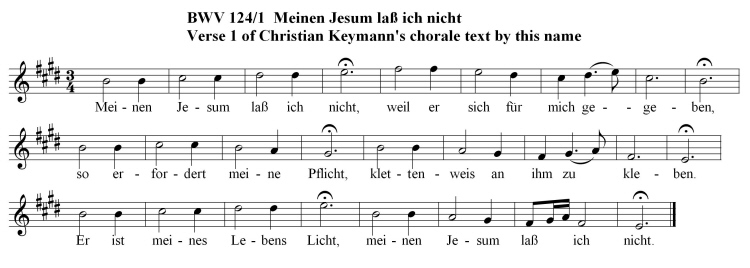
|
|

|
|
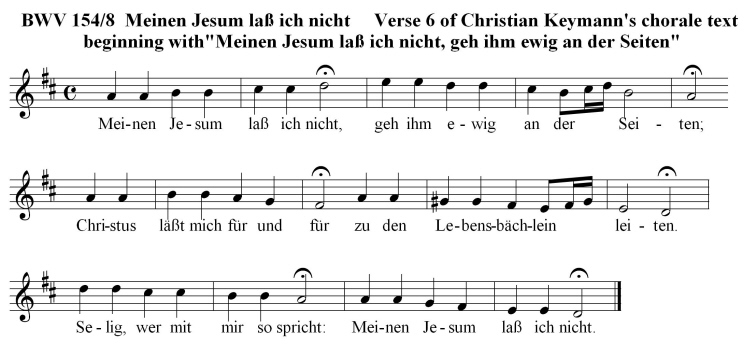
|
|
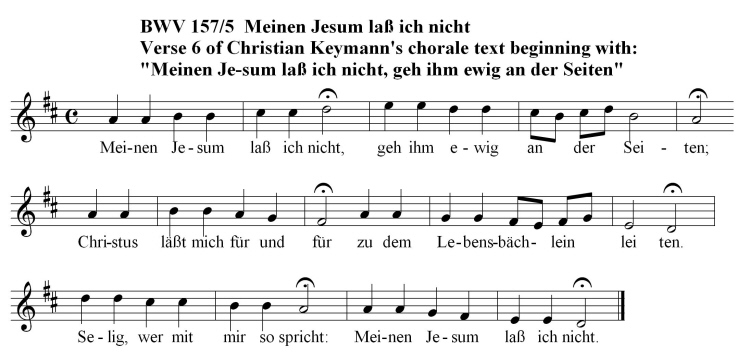
|
|
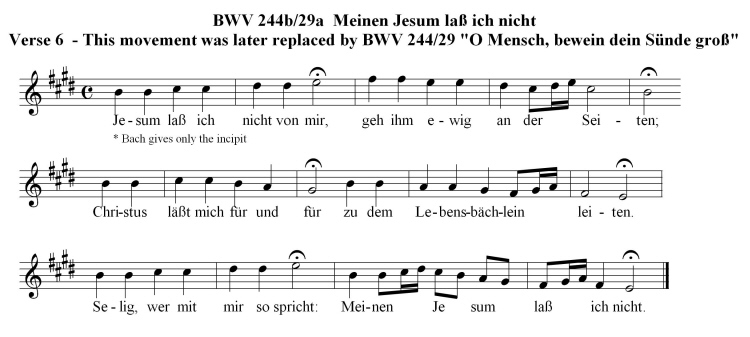
|
|
BWV 244b/29a: later replaced with BWV 244/29 O Mensch, bewein dein Sünde groß. |
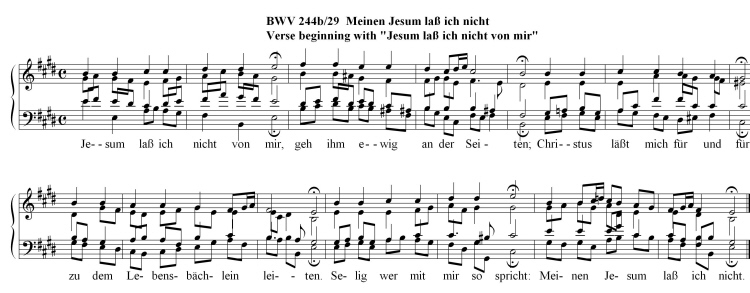 |
|
See: Full Score of BWV 244b/29 (from the NBA II/5b, p. 119 [for study purposes only!]) |
| |
|
Untexted: |
|
Ver |
Work |
Mvt. |
Year |
Br |
RE |
KE |
Di |
BC |
Score |
Music Examples |
|
- |
BWV 163 |
Mvt. 5 |
1715 |
- |
- |
- |
- |
A 158:5 |
- |
Mvt. 5 (Leusink) |
|
- |
BWV 380 |
- |
? |
298 |
242 |
299 |
86 |
F141:1 |
PDF |
Chorale (MG) [midi] |
|
BWV 163/5: the CM is played by the strings.
BWV 380: probably from a lost cantata. |
|
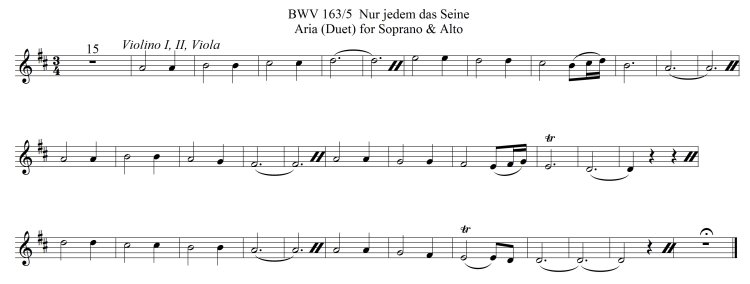
|
|

|
| |
|
Alternate Melodies |
|
1st Alternate Melody: EKG: 251 |
|
An important alternate melody not used by Bach has survived in the current German Lutheran hymnal with a melody by Johann Ulich as it first appeared in “Sieben-Fache Welt- and Himmels-Capell” (edited by Michael Schernak) Wittenberg, 1674. Johann Ulich (born in Leipzig in 1634 and died in Wittenberg in 1712) originally served as organist in Torgau and later became cantor and organist in the City Church {Stadtkirche] in Wittenberg. His melody as it still appears in the EKG today looks like this: |
|

|
| |
|
2nd Alternate Melody: Zahn: 3448a
The composer is not given, but the text superscript in the Breitkopf edition of chorale harmonizations by J.S. Bach is essentially the same. Zahn gives the title for this melody as “Jesus ist mein Aufenthalt” |
| |
|
Use of the 2nd Alternate Melody by Bach: |
|
Untexted: |
|
Ver |
Work |
Mvt. |
Year |
Br |
RE |
KE |
Di |
BC |
Score |
Music Examples |
|
- |
BWV 379 |
- |
? |
151 |
241 |
151 |
86 |
F122.1 |
PDF |
Chorale (MG) [midi] |
|
BWV 379: probably from a lost cantata. |
|
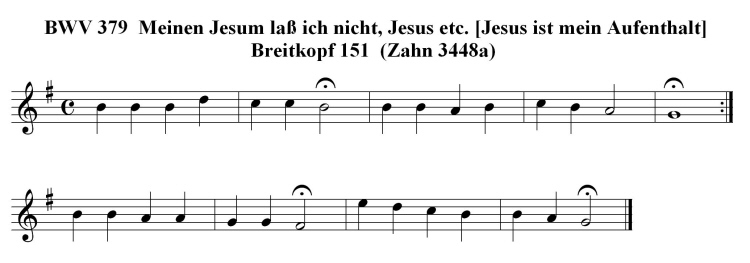
|
| |
|
Use of the Chorale Melody by other composers: |
|
Other Composers with the caveat that one of the alternate melodies may be involved: |
|
Georg Christoph Bach (1642-1697):
Meinen Jesum lass ich nicht is one of 4 extant cantatas which this Bach composed: The 4 cantatas are: Vom Himmel hoch, da komm ich her; O wie selig seid ihr doch, ihr Frommen; O Haupt voll Blut und Wunden; Meinen Jesum lass ich nicht.
Here is Christoph Wolff’s short biography of this composer: |
|
>>Georg Christoph Bach (born in Erfurt, 6 Sept 1642; died in Schweinfurt, 27 April 1697). Son of Christoph Bach. He was trained in music at Arnstadt, and was evidently academically gifted; he attended the Gymnasium Casimiranum in Coburg (1663–5) and Leipzig University (1665–6). In 1668 he became Kantor and organist in Themar, and from 1688 he was Kantor at St Johannis in Schweinfurt, where his uncles Johann and Heinrich Bach had been organists. A vocal concerto by him survives: Siehe, wie fein und lieblich ist es for two tenors, bass, violin, three gambas and continuo. It was composed on his 47th birthday, evidently for performance with his brothers, the twins Ambrosius and Christoph, probably at some family gathering. A Schweinfurt inventory of 1689 lists four other vocal works: Gott ist unser Zuversicht, Meinen Jesum lass ich nicht, Wie lieblich sind auf den Bergen and Wohl her, lasset uns wohl leben.<<
Source: Grove Music Online, Oxford University Press, 2005, acc. 12/15/05
|
|
Georg Ludwig Agricola (1643-1676):
Meinen Jesum laß ich nicht for 12-18 voices/parts |
|
Johann Gottfried Walther (1684-1748):
Chorale Prelude for Organ in Musicalische Vorstellung Zwey Evangelischer Gesänge, nemlich: Meinen Jesum laß ich nicht und Jesu meine Freude (Erfurt 1712). |
|
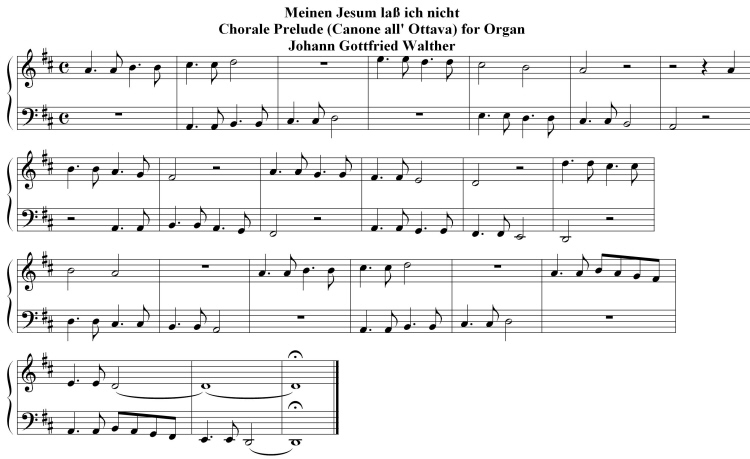
|
|
Another Chorale Prelude attributed to Walther may really be by Scheidemantel:
Meinen Jesum laß ich nicht (in der Frankenbergerschen Handschrift als Werk von F. Chr. Scheidemantel). |
|
Johann Georg Neidhardt (c1685-1722):
Das schöne Kirchenlied:Meinen Jesum laß ich nicht ...vor den General-Baß ...gesetzt (1722), Chorale (or solo?) setting with bc. |
|
Georg Philipp Telemann (1681-1767):
Meinen Jesum lass ich nicht (Neumeister), Cantata for 2 ob, bn, str, bc, 1:1097 (1724) |
|
Johann Ludwig Krebs (1713-1780):
2 Chorale Preludes for Organ on Meinen Jesum laß ich nicht |
|
Max Reger (1873-1916):
Meinem Jesum laß ich nicht, Chorale Prelude for Organ, Op. 67/26 (1902)
Setting of Meinen Jesum lass ich nicht for Soprano, Mixed Choir, Violin, Viola., and Organ (1905) published in 1906.
Meinem Jesum laß ich nicht, Chorale Prelude for Organ, Op. 135a/17 (1914) |
|
Sigfrid Karg-Elert (1877-1933):
Meinen Jesum laß ich nicht, chorale improvisation for organ (Fughetta), Op. 65/49 |
| |
|
Sources: NBA, vols. III/2.1 & 2.2 in particular [Bärenreiter, 1954 to present] and the BWV ("Bach Werke Verzeichnis") [Breitkopf & Härtel, 1998]
The PDF files of the Chorales were contributed by Margaret Greentree J.S. Bach Chorales
Software: Capella 2004 Software, version 5.1.
Prepared by Thomas Braatz & Aryeh Oron (December 2005 - October 2010)
Thabks to contributors: Margaret Greentree (October 2010) |